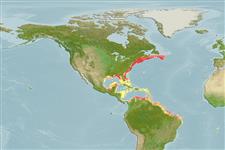Environment: milieu / climate zone / depth range / distribution range
Écologie
marin démersal; océanodrome (Ref. 51243); profondeur 1 - 477 m (Ref. 5951), usually 75 - 150 m (Ref. 5951). Subtropical; 46°N - 16°S, 97°W - 5°W
Western Atlantic: Cape Cod in Massachusetts to northeastern Florida in USA and northern Gulf of Mexico. Reported in eastern Atlantic: St. Helena (Ref. 5288). Northwest Atlantic: Canada (Ref. 5951).
Taille / Poids / Âge
Maturity: Lm ? range ? - ? cm
Max length : 230 cm TL mâle / non sexé; (Ref. 7251); common length : 100.0 cm TL mâle / non sexé; (Ref. 3715); poids max. publié: 40.0 kg (Ref. 7251)
Occurs from shallow inshore waters to depths of 477 m and up to 260 m in the Gulf of Maine (Ref. 7135). Benthic (Ref. 5951). Nocturnal predators (Ref. 93252). Feeds mainly on fishes, but also on shrimps and small shellfish. Commonly caught by anglers along piers, docks and jetties in middle Atlantic states.
Life cycle and mating behavior
Maturité | Reproduction | Frai | Œufs | Fécondité | Larves
Robins, C.R. and G.C. Ray, 1986. A field guide to Atlantic coast fishes of North America. Houghton Mifflin Company, Boston, U.S.A. 354 p. (Ref. 7251)
Statut dans la liste rouge de l'IUCN (Ref. 130435)
Menace pour l'homme
Harmless
Utilisations par l'homme
Pêcheries: intérêt commercial mineur
Plus d'informations
Taille/ÂgeCroissanceLongueur-poidsLongueur-longueurFréquences de longueursMorphométrieMorphologieLarvesDynamique des populations larvairesRecrutementAbondanceBRUVS
RéférencesAquacultureProfil d'aquacultureSouchesGénétiqueElectrophoresesHéritabilitéPathologiesTraitementNutrientsMass conversion
CollaborateursImagesStamps, Coins Misc.SonsCiguateraVitesseType de nageSurface branchialeOtolithesCerveauxVision
Outils
Articles particuliers
Télécharger en XML
Sources Internet
Estimates based on models
Preferred temperature (Ref.
123201): 7.1 - 25.2, mean 19.7 °C (based on 61 cells).
Phylogenetic diversity index (Ref.
82804): PD
50 = 0.5000 [Uniqueness, from 0.5 = low to 2.0 = high].
Bayesian length-weight: a=0.00049 (0.00027 - 0.00088), b=3.25 (3.09 - 3.41), in cm total length, based on LWR estimates for this species & Genus-body shape (Ref.
93245).
Niveau trophique (Ref.
69278): 4.5 ±0.8 se; based on diet studies.
Résilience (Ref.
120179): Faible, temps minimum de doublement de population : 4,5 à 14 années (Assuming tm>4).
Fishing Vulnerability (Ref.
59153): Very high vulnerability (90 of 100).
Climate Vulnerability (Ref.
125649): High vulnerability (60 of 100).
Nutrients (Ref.
124155): Calcium = 27.1 [15.1, 52.3] mg/100g; Iron = 0.781 [0.431, 1.338] mg/100g; Protein = 18.8 [15.9, 21.7] %; Omega3 = 0.284 [0.126, 0.807] g/100g; Selenium = 62.7 [30.7, 130.0] μg/100g; VitaminA = 9.12 [2.53, 34.69] μg/100g; Zinc = 0.384 [0.274, 0.565] mg/100g (wet weight);
